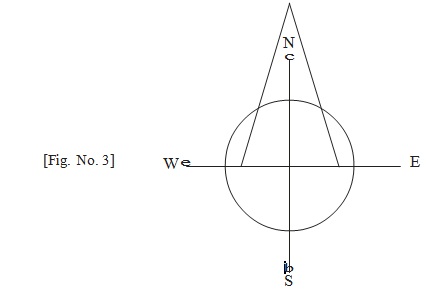The cosmic space is finite and bounded. Therefore, it is believed to have a definite volume, the mathematical computation of which will be discussed later on. Here, we discuss the size explained through illustration or example.
Gautama asked, ‘How big is the loka?’
Bhagavān Mahāvīra replied: “Gautama! This universe is very big. It is innumerable yojanas in length and breadth in eastern, western, northern, southern, upward and downward directions.”[1] The enormous size given here as “innumerable yojanas” is explained through an illustration in which it is imagined that gods moving at a very high speed fly to reach the end of the universe. The dimensions of the universe are given in terms of the distances covered by the gods.[2]
The detail given in this example is as follows:
To explain the speed of the gods, it is imagined that there are four goddesses (dikkumāries). They are standing on the jagati (wall) situated on the periphery of the Jambūdvīpa. The wall is 8 yojanas in height.[2] In Jain cosmography, it is given that the Jambūdvīpa has a diameter of 1,00,000 yojanas, and its circumference is 3,16,227 yojanas, 3 kośa, 128 dhanuṣyas a 13½ aṅgulas.[4] Now, there is the Mount Meru in the centre of the Jambūdvīpa. The total height of the Mount Meru is also 1,00,000 yojanas. The mountain has gone 1000 yojanas below the samabhāgabhūmi (the perfectly even land) and is 99,000 yojanas above it. There is one culikā (peak) on the mountain, which is 40 yojanas[5] in height. Six gods are standing on the culikā. Now, it is imagined that the four goddesses throw four balls (balipiṇḍas) in four directions, by standing with their faces outwards towards each direction respectively. (See fig. 3).

Now one of the gods standing on the cūlika dives to catch these balls. He flies with the highest speed and catches all the four balls before they fall on the ground. This speed is called as the śīghra gati.
Now, to illustrate the vastness of the universe, it is imagined that the above six gods start travelling in all he six directions, viz., east, west, north, south, upwards and downwards, with the śīghra gati (described bove). The tiryak loka[6] is 1 rajju[7] in length and breadth, and Mount Meru is right in the centre of the tiryak loka. Now, when the gods started their journey, a child was born in a family. His parents lived for some time, after which their lifespan ended. The life-span of the child born was 1000 years, which also got ended. Then seven generations of that person, each having a life-span of 1000 years also passed away. The gods continue their journey, but had not reached the end. After that, the total historical record of that family also became extinct due to the passage of time. Even then, the gods could not reach the end. But they had covered larger part of the total distance, and only a smaller part still remained to be covered. The distance which remains uncovered was only an innumerableth part of the distance covered.[8]
Although it is not possible to find out exactly the dimensions of the universe from the above example, yet one can get the idea how big the universe is. Two facts are needed to find out the exact dimensions:
- The exact speed of the gods.
- The exact time taken to cover the distance as described.
In order to know the first fact, one should know the speed of the falling down of the balls. But in absence of the knowledge of the law governing gravitational effect in that region, it is not possible to find it out. The second fact is also difficult to know, because the exact period of “abolishment of the historical records” is also not known. Thus, the above example can only give us the idea of enormous vastness of the universe.
A similar example is given to comprehend the dimensions of the supra-cosmic space.[9] In this illustration, it is imagined that there are eight goddesses who throw the balls in eight directions viz., four main directions and four sub-directions (i.e., east, west, north, south, north-east, south-east, south-west and north-west).
The god, with the fastest speed catches them all before falling on the ground. Ten gods travel in ten directions to reach the end of the supra-cosmic space. (This is only imaginary example, as no one can enter into supra-cosmic space, for there is no dharmāstikāya). Now, the distance covered by the gods is only infinitesimal part of the uncovered distance. This example explains the infinite dimension of the supra-cosmic space.[10]
Yojanānāṃ sahasraṃ cāvagāḍho vasudhāntare..
Lakṣayojanamāno’sau sarvāgreṇa bhavediti.
Catvāriṃśadadhikāni cūlāyā yojanāni tu.. - Lokaprakāśaḥ, 18.15,16.
 Prof. Muni Mahendra Kumar
Prof. Muni Mahendra Kumar

